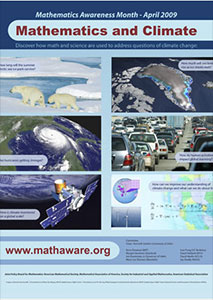Apr 13 2009
In 1994, University of Utah mathematician Ken Golden went to the Eastern Weddell Sea for the Antarctic Zone Flux Experiment. The sea's surface is normally covered with sea ice, the complex composite material that results when sea water is frozen. During a powerful winter storm, Golden observed liquid sea water welling up and flooding the sea ice surface, producing a slushy mixture of sea water and snow that freezes into snow-ice. With his mathematician's eyes he observed this phenomenon and said to himself: "That's percolation!"

Golden is an expert in mathematical models of percolation, a physical process in which a fluid moves and filters through a porous solid. Soon after the 1994 trip he started trying to understand how the mathematics of percolation could describe aspects of the formation and behavior of sea ice. His results appeared in a landmark paper in Science in 1998, written with co-authors S. F. Ackley and V. I. Lytle. Ever since then, Golden has been a leader in the international effort to model polar climate dynamics and has brought a new level of rigor and precision to this area of research.
Golden describes the mathematics he and collaborators have developed in "Climate Change and the Mathematics of Transport in Sea Ice", which will appear this month in the Notices of the American Mathematical Society. His article marks Mathematics Awareness Month, celebrated each year in April. For 2009, the theme of Mathematics Awareness Month is "Mathematics and Climate". Golden is serving as Chair of the Mathematics Awareness Month Committee this year.
Sea ice is very different from icebergs, glaciers, and ice sheets, all of which originate on land. Sea ice is a polycrystalline composite of pure ice with liquid brine inclusions, plus air pockets and solid salts. As the boundary layer between the ocean and atmosphere in the polar regions, sea ice functions as both ocean sunscreen and blanket, playing a key role as both an indicator and agent of climate change.
Golden discovered that, as a percolation phenomenon, sea ice has similarities to compressed powders used in the development of stealthy (or radar-absorbing) composites. He was able to build on existing models developed for these powders to create a percolation-based model for sea ice. His model captured one of the key features of sea ice: When the volume of brine is under about 5 percent, the sea ice is impermeable to fluid flow. But when the brine volume passes that critical 5-percent threshold, the sea ice suddenly becomes permeable to fluid flow. This 5-percent threshold corresponds to a critical temperature of -5 degrees Celsius for a typical bulk salinity of 5 parts per thousand. At first Golden did not quite realize what a breakthrough this work represented. "It was just a cool observation, with the comparison to stealthy materials," he remarked. "I didn't realize how important it was at the time." But today, polar scientists routinely refer to the "rule of fives" that emerged from Golden's work.
One of the reasons the work was so important, Golden explained, is that the permeability of sea ice is at the heart of a range mechanisms that control the dynamics of polar climate: the formation of snow-ice, the evolution of surface melt ponds that determine how much solar radiation sea ice reflects or absorbs, gas and thermal exchange processes, and more. The permeability also controls nutrient replenishment and other processes critical to the biology of algal and bacterial communities living in the brine inclusions of sea ice, which support the rich food webs of the polar oceans. "You name it, and permeability and percolation play a key role," he said. "But before our work there was no theoretical basis to support this understanding."
In recent years, with Hajo Eicken of the University of Alaska Fairbanks and other colleagues, Golden has developed a whole host of mathematical approaches to understanding and predicting changes in the permeability of sea ice. These include establishing rigorous mathematical bounds on fluid permeability. Such bounds had been found almost 100 years ago for the effective electrical conductivity of composites. But, Golden noted, "the analogues for bounds on fluid transport were found 100 years later partly because the fluid problem is more difficult." He has also developed multigrid and inverse methods and drawn on techniques from complex analysis and functional analysis. "We have tried to cover all the bases to predict the permeability of sea ice," Golden said.
Golden has also capitalized on his research to bring exciting opportunities to undergraduate students. Over the past several years, six students have accompanied him on research trips to the Arctic. One of the star students has been Amy Heaton, a chemistry major who as a 17-year-old took a calculus class with Golden. In her sophomore year she helped Golden present their joint work in the US Congress. In her junior year he sent Heaton to New Zealand to present to a group of physicists some of the results she and Golden had obtained on percolation models of sea ice. Heaton just finished a PhD in chemistry a year ago.
In September and October of 2007 Golden took an outstanding mathematics student, Adam Gully, to Antarctica on the Australian Sea Ice Physics and Ecosystem Experiment. They conducted experiments on fluid and electrical transport in sea ice, making the first-ever measurements of fluid permeability in Antarctic pack ice, to validate their mathematical models and observe new phenomena. Gully is currently working on his Ph.D. in mathematics with Golden.